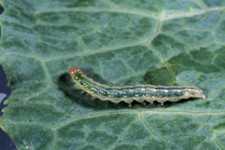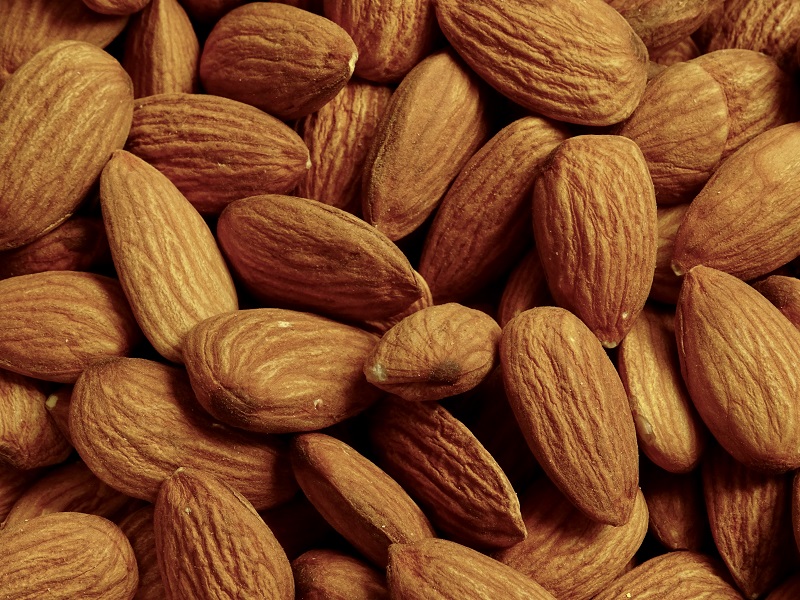Pest Of The Month: Beet Webworms

Identification
Three species of beet webworms, sometimes called spinach moth, attack leafy vegetables in Florida. These are spotted beet webworm (Hymenia perspectalis), the southern beet webworm (Herpetogramma bipunctalis), and [pictured] the Hawaiian beet webworm (Spoladea recurvalis). These are tropical pests with a worldwide distribution. In the U.S., they are primarily southern insects, but may be found as far north as New York and Illinois during the warmer months. Their occurrence is typically not very common. When present in large numbers, the damage can be very severe.
In the fall, growers in South Florida should scout sensitive leafy vegetable crops for this pest soon after planting, especially if large numbers are present on pigweeds on field margins.
Adult Hawaiian beet webworms and spotted beet webworms are similar in appearance and are small buff to smoky brown moths with white wing markings. Southern beet webworm moths are yellowish gray with indistinct markings on the wings. Adults are most active at night but often can be readily observed flying out of the foliage during the day while walking through the field.
Eggs may be deposited singly or in rows of several eggs and are typically placed on the underside of leaves adjacent to large veins. The larvae of each of these species are green and bear numerous hairs. On the spotted beet webworm and southern beet webworm, these hairs arise from dark raised spots, which are lacking in the Hawaiian beet webworm. Mature larvae drop to the ground to pupate beneath the soil surface.
In the fall, growers in South Florida should scout sensitive leafy vegetable crops for this pest soon after planting, especially if large numbers are present on pigweeds on field margins.
Adult Hawaiian beet webworms and spotted beet webworms are similar in appearance and are small buff to smoky brown moths with white wing markings. Southern beet webworm moths are yellowish gray with indistinct markings on the wings. Adults are most active at night but often can be readily observed flying out of the foliage during the day while walking through the field.
Eggs may be deposited singly or in rows of several eggs and are typically placed on the underside of leaves adjacent to large veins. The larvae of each of these species are green and bear numerous hairs. On the spotted beet webworm and southern beet webworm, these hairs arise from dark raised spots, which are lacking in the Hawaiian beet webworm. Mature larvae drop to the ground to pupate beneath the soil surface.
Survival And Spread
Beet webworms are active throughout the year in warmer areas and may produce several generations per year. Under ideal conditions, one generation can be completed in as little as 30 days. As the season progresses, webworms will migrate north from year-round sanctuaries in southern areas.
The damage caused by the three species of webworms is nearly identical. They consume large amounts of foliage. Young larvae typically feed on the lower surface of leaves skeletonizing leaves. As they mature, they may consume the entire leaf and can completely defoliate a field in a very short period of time. As they feed, they may spin a web drawing or folding individual leaves together to form a tube in which they hide when disturbed, although presence of webbing is often minimal compared to other species of webworm.
The damage caused by the three species of webworms is nearly identical. They consume large amounts of foliage. Young larvae typically feed on the lower surface of leaves skeletonizing leaves. As they mature, they may consume the entire leaf and can completely defoliate a field in a very short period of time. As they feed, they may spin a web drawing or folding individual leaves together to form a tube in which they hide when disturbed, although presence of webbing is often minimal compared to other species of webworm.
Management Methods
Weed control is an important management strategy as infestations often appear to be worse in weedy fields. No treatment thresholds are available for webworms. Because of the rapidity with which webworm can defoliate plants, growers should closely monitor fields in which webworms are active and apply a treatment if defoliation continues.
2
2
5
Pest Of The Month: Beet Webworms










